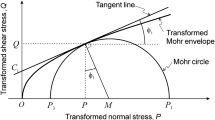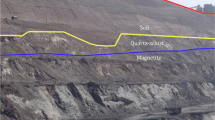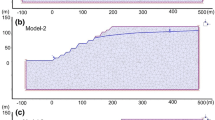Abstract
The paper presents a complex limit state criterion, which allows to predict limit states of rock masses and its potential transition to discontinuum state. The idea of the complex limit state criterion is based on the fact that the stress-strain state of the rock mass should be evaluated not by one particular failure criterion, but by a system of criteria taking physical specifics of each criterion into account. The proposed limit state criterion is universal and can be used for the evaluation of the rock mass state in the vicinity of any geotechnical structures. The main aim of the paper is to establish a criterion that will accurately separate quasi-continuum states of rock masses from discontinuum ones. This separation can be further used for numerical simulation of geomechanical behavior of rock masses in the vicinity of underground structures using continuum methods, such as the finite element method (FEM), and discrete methods, such as the discrete element method or distinct element method (DEM) in correspondent areas. The application of the proposed complex limit state criterion is demonstrated on the classic examples of rock mass strength/failure assessment in the vicinity of a single mining excavation. The results of the study can be used either for the determination of potential failure zones in the rock mass in the vicinity of underground structures or for the development of specialized CAE software, which are based on coupled FEM-DEM numerical methods.

摘要
在对岩体的应力-应变状态进行评估时, 应当采用考虑岩体物理特性的准则体系, 而非一个特定的破坏准则. 为此, 本文提出了一个用以预测岩体极限状态及其由连续向不连续状态潜在转变的复杂极限状态准则. 该准则具有通用的极限状态标准, 可用于评估任何岩体结构附近的极限状态. 本文主要是建立一个能够准确区分岩体准连续状态和非连续状态的准则, 并可进一步用于地下结构附近岩体地质力学数值模拟的连续介质方法(如有限元法)及离散介质方法(如离散元方法或相应的离散单元法). 以上的复杂极限状态准则在对单个采矿开挖区附近岩体强度/破坏评估的经典应用中得到证实. 本文研究工作不仅可用于确定地下结构附近岩体的潜在破坏区域, 还可用于开发基于FEM-DEM耦合数值方法的CAE专业软件
Similar content being viewed by others
References
S. H. Chen, Computational Geomechanics and Hydraulic Structures (Springer, Singapore, 2019).
D. Kolymbas, Advanced Mathematical and Computational Geomechanics (Springer, Berlin, Heidelberg, 2003).
A. Bobet, Numerical methods in geomechanics, Ara. J. Sci. Eng. 35, 27 (2010).
F. Zhu, and J. Zhao, Modeling continuous grain crushing in granular media: A hybrid peridynamics and physics engine approach, Comput. Methods Appl. Mech. Eng. 348, 334 (2019).
M. Zhuravkov, S. Ji, and A. Kanavalau, Modeling of deformation processes in rock massif in the vicinity of underground goafs considering the formation of discontinuity zones, Theor. Appl. Mech. Lett. 10, 92 (2020).
J. Liu, Z. Nan, and P. Yi, Validation and application of three-dimensional discontinuous deformation analysis with tetrahedron finite element meshed block, Acta Mech. Sin. 28, 1602 (2012).
Z. Wu, L. Ma, and L. Fan, Investigation of the characteristics of rock fracture process zone using coupled FEM/DEM method, Eng. Fract. Mech. 200, 355 (2018).
Y. J. Ning, X. M. An, Q. Lü, and G. W. Ma, Modeling rock failure using the numerical manifold method followed by the discontinuous deformation analysis, Acta Mech. Sin. 28, 760 (2012).
M. H. Mehranpour, and P. H. S. W. Kulatilake, Comparison of six major intact rock failure criteria using a particle flow approach under true-triaxial stress condition, Geomech. Geophys. Geo-energ. Georesour. 2, 203 (2016).
A. F. Revuzhenko, Rock failure criteria based on new stress tensor invariants, J. Min. Sci. 50, 437 (2014).
H. Xie, L. Li, R. Peng, and Y. Ju, Energy analysis and criteria for structural failure of rocks, J. Rock Mech. Geotech. Eng. 1, 11 (2009).
Y. Yao, J. Hu, A. Zhou, T. Luo, and N. Wang, Unified strength criterion for soils, gravels, rocks, and concretes, Acta Geotech. 10, 749 (2015).
H. Gao, and Y. R. Zheng, Discussion on strength criteria, Mater. Res. Innovations 15, s504 (2011).
L. Zhang, and H. Zhu, Three-dimensional Hoek-Brown strength criterion for rocks, J. Geotech. Geoenviron. Eng. 133, 1128 (2007).
A. Nadai, Theory of Flow and Fracture of Solids (McGraw-Hill Co., New York, 1963).
S. A. Chizhik, M. A. Zhuravkov, A. B. Petrovskiy, V. Y. Prushak, and D. A. Puzanov, Ultimate state criteria and strength characteristics of the rock massifs being undermined repeatedly, Proc. Natl. Acad. Sci. Belarus Phys.-Tech. Ser. 66, 420 (2021).
H. Jiang, and Y. Xie, A note on the Mohr-Coulomb and Drucker-Prager strength criteria, Mech. Res. Commun. 38, 309 (2011).
M. Kwasniewski, X. Li, and M. Takahashi, True Triaxial Testing of Rocks (CRC Press, Boca Raton, 2012).
W. C. Zhu, J. Wei, J. Zhao, and L. L. Niu, 2D numerical simulation on excavation damaged zone induced by dynamic stress redistribution, Tunnelling Underground Space Tech. 43, 315 (2014).
F. Gao, D. Stead, and H. Kang, Numerical simulation of squeezing failure in a coal mine roadway due to mining-induced stresses, Rock Mech. Rock Eng. 48, 1635 (2015).
M. Zhuravkov, S. Hvesenya, and S. Lapatsin, Durability analysis of underground structures based on various creep models of the enclosing salt rock massif, E3S Web Conf. 201, 01007 (2020).
Author information
Authors and Affiliations
Corresponding author
Additional information
Author contributions
Research design, conceptualization, data curation and formal analysis were performed by Michael Zhuravkov and Siarhei Lapatsin. Investigation, methodology, and visualization were defined and performed by Siarhei Lapatsin in addition to writing the original paper draft. Supervison, validation of the results and draft review/editing were performed by Shunying Ji and Michael Zhuravkov.
Rights and permissions
About this article
Cite this article
Zhuravkov, M., Lapatsin, S. & Ji, S. Complex limit state criterion for rock masses. Acta Mech. Sin. 39, 722194 (2023). https://doi.org/10.1007/s10409-022-22194-x
Received:
Accepted:
Published:
DOI: https://doi.org/10.1007/s10409-022-22194-x




